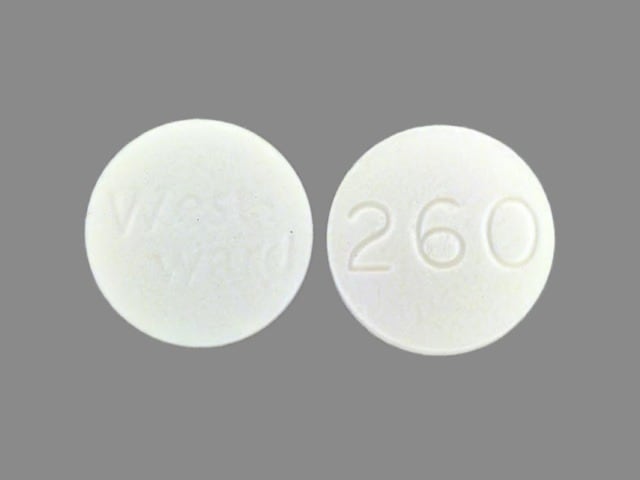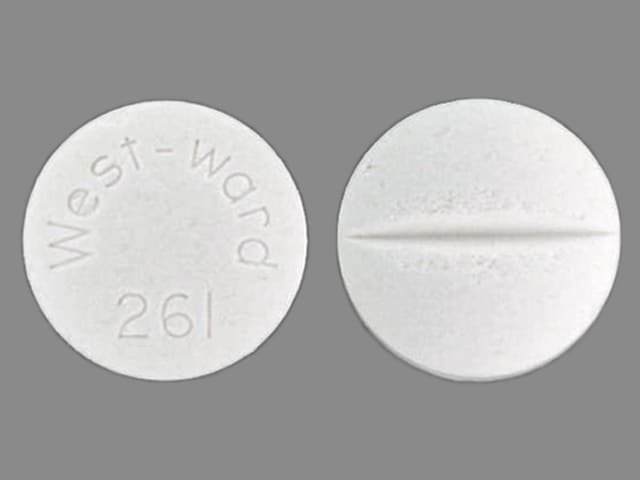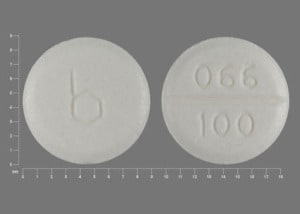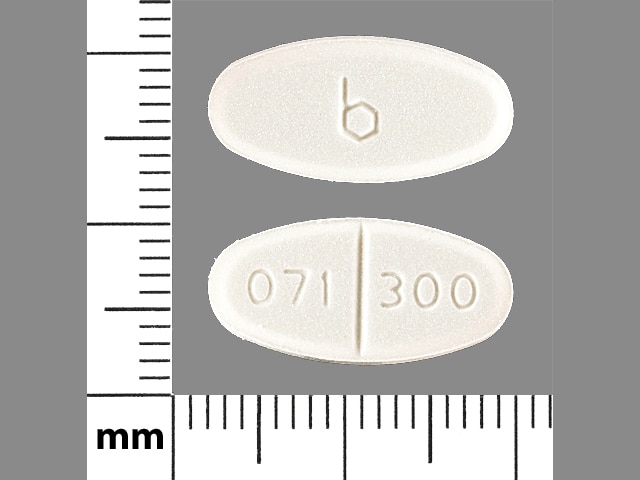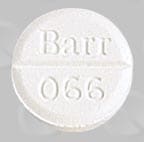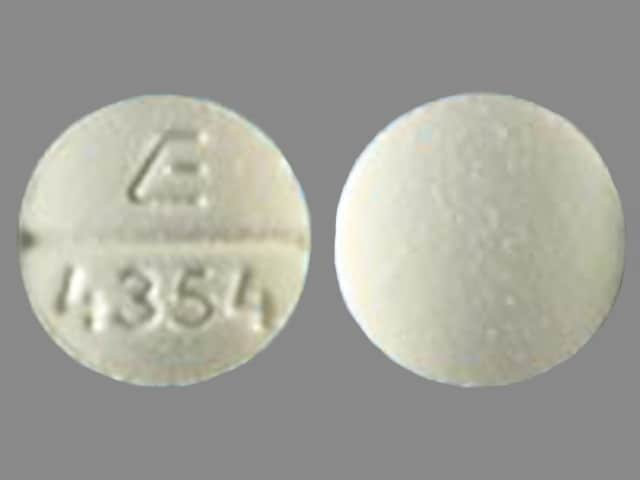Boxed Warning
Hepatitis:
Severe and sometimes fatal hepatitis associated with isoniazid therapy has been reported and may occur or may develop even after many months of treatment. The risk of developing hepatitis is age related. Approximate case rates by age are as follows: less than 1/1,000 for persons younger than 20 years of age, 3/1,000 for persons in the 20 to 34 year age group, 12/1,000 for persons in the 35 to 49 year age group, 23/1,000 for persons in the 50 to 64 year age group, and 8/1,000 for persons older than 65 years. The risk of hepatitis is increased with daily consumption of alcohol. Precise data to provide a fatality rate for isoniazid-related hepatitis are not available; however, in a US Public Health Service surveillance study of 13,838 persons taking isoniazid, there were 8 deaths among 174 cases of hepatitis.
Therefore, carefully monitor patients given isoniazid and interview patients at monthly intervals. For persons 35 years and older, in addition to monthly symptom reviews, measure hepatic enzymes (specifically, AST and ALT) prior to starting isoniazid therapy and periodically throughout treatment. Isoniazid-associated hepatitis usually occurs during the first 3 months of treatment. Usually, enzyme levels return to normal despite continuance of drug, but, in some cases, progressive liver dysfunction occurs. Other factors associated with an increased risk of hepatitis include daily use of alcohol, chronic liver disease, and injection drug use. A recent report suggests an increased risk of fatal hepatitis associated with isoniazid among women, particularly black and Hispanic women. The risk may also be increased during the postpartum period. Consider more careful monitoring in these groups, possibly including more frequent laboratory monitoring. If abnormalities of liver function exceed 3 to 5 times the upper limit of normal (ULN), strongly consider discontinuation of isoniazid. Liver function tests are not a substitute for a clinical evaluation at monthly intervals or for the prompt assessment of signs or symptoms of adverse reactions occurring between regularly scheduled evaluations. Instruct patients to immediately report signs or symptoms consistent with liver damage or other adverse reactions. These include any of the following: unexplained anorexia, nausea, vomiting, dark urine, icterus, rash, persistent paresthesia of the hands and feet, persistent fatigue, weakness or fever of greater than 3-day duration or abdominal tenderness, especially right upper quadrant discomfort. If these symptoms appear or if signs suggestive of hepatic damage are detected, promptly discontinue isoniazid, because continued use of the drug in these cases has been reported to cause a more severe form of liver damage.
Give patients with tuberculosis who have hepatitis attributed to isoniazid appropriate treatment with alternative drugs. If isoniazid must be reinstituted, do so only after symptoms and laboratory abnormalities have cleared. Restart the drug in very small and gradually increasing doses and withdraw immediately if there is any indication of recurrent liver involvement.
Defer preventive treatment in persons with acute hepatic diseases.
Dosage Forms
Excipient information presented when available (limited, particularly for generics); consult specific product labeling.
Solution, Injection:
Generic: 100 mg/mL (10 mL)
Syrup, Oral:
Generic: 50 mg/5 mL (473 mL)
Tablet, Oral:
Generic: 100 mg, 300 mg
Pharmacology
Mechanism of Action
Isoniazid inhibits the synthesis of mycoloic acids, an essential component of the bacterial cell wall. At therapeutic levels isoniazid is bacteriocidal against actively growing intracellular and extracellular Mycobacterium tuberculosis organisms.
Pharmacokinetics/Pharmacodynamics
Absorption
Oral, IM: Rapid and complete; food reduces rate and extent of absorption
Distribution
All body tissues and fluids including CSF
Metabolism
Hepatic to acetylisoniazid with decay rate determined genetically by acetylation phenotype; undergoes further hydrolysis to isonicotinic acid and acetylhydrazine
Excretion
Urine (75% to 95% as unchanged drug and metabolites); small amounts excreted in feces and saliva
Time to Peak
Serum: 1 to 2 hours
Half-Life Elimination
May be prolonged in patients with impaired hepatic function or severe renal impairment
Fast acetylators: 30 to 100 minutes; Slow acetylators: 2 to 5 hours
Protein Binding
10% to 15%
Use: Labeled Indications
Active tuberculosis infections: Treatment of susceptible active tuberculosis (eg, Mycobacterium tuberculosis) infections.
Latent tuberculosis infection: Treatment of latent tuberculosis infection (LTBI) caused by Mycobacterium tuberculosis (also referred to as prophylaxis or preventive therapy). Note: To identify candidates for LTBI treatment, refer to CDC guidelines (https://www.cdc.gov/tb/publications/ltbi/default.htm) for current recommendations.
Use: Off Label
Treatment of nontuberculous mycobacterium (eg, Mycobacterium kansasii)yes
Based on the American Thoracic Society/Infectious Diseases Society of America (ATS/IDSA) Diagnosis, Treatment and Prevention of Nontuberculous Mycobacterial Diseases guidelines, isoniazid given as combination therapy for the treatment of nontuberculous mycobacterium (eg, M. kansasii) is effective and recommended in the management of this condition.
Contraindications
Hypersensitivity to isoniazid or any component of the formulation, including drug-induced hepatitis; acute liver disease; previous history of hepatic injury during isoniazid therapy; previous severe adverse reaction (drug fever, chills, arthritis) to isoniazid
Dosage and Administration
Dosing: Adult
Tuberculosis, active (drug susceptible): Oral, IM: Note: Always administer in combination with other antitubercular drugs. Concomitant pyridoxine is also recommended in any patient at risk for neuropathy (eg, patients with HIV infection, diabetes, alcoholism, nutritional deficiency, chronic renal failure, advanced age) (ATS/CDC/IDSA [Nahid 2016]).
ATS/CDC/IDSA Drug-susceptible tuberculosis guideline recommendations (Nahid 2016):
Dosing:
Once-daily therapy: 5 mg/kg/dose (usual dose: 300 mg) once daily Note: The preferred frequency of administration is once daily during the intensive and continuation phases; however, 5 days per week administration by directly observed therapy (DOT) is an acceptable alternative.
Three-times-weekly DOT: 15 mg/kg/dose (usual dose: 900 mg) administered 3 times weekly
Twice-weekly DOT: 15 mg/kg/dose (usual dose: 900 mg) administered twice weekly
Once-weekly DOT: 15 mg/kg/dose (usual dose: 900 mg) administered once weekly
Regimens: Treatment regimens for pulmonary tuberculosis and tuberculous meningitis consist of an initial 2-month phase of a 4-drug regimen, followed by a continuation phase of an additional 4 to 7 months of isoniazid and rifampin for pulmonary tuberculosis and a continuation phase of an additional 7 to 10 months of isoniazid and rifampin for tuberculous meningitis (optimal duration is not defined although continuation phase must continue for a minimum of 7 additional months). Adjunctive corticosteroid therapy (eg, dexamethasone, prednisolone) tapered over 6 to 8 weeks is also recommended for tuberculous meningitis. Isoniazid frequency and dosing differs depending on treatment regimen selected; consult current Drug-sensitive TB guidelines (ATS/CDC/IDSA [Nahid 2016]).
Tuberculosis, latent infection: Oral, IM: Note: Concomitant administration of pyridoxine is recommended in malnourished patients, pregnant or breastfeeding women, or those prone to neuropathy (eg, patients with HIV-infection, diabetes, or chronic alcohol abusers) (CDC 2013; manufacturer's labeling).
Isoniazid monotherapy:
Non-HIV infected: 5 mg/kg (maximum: 300 mg per dose) once daily for 6 or 9 months or 15 mg/kg (maximum: 900 mg per dose) twice weekly for 6 or 9 months. Note: 9 months is optimal; 6 months may be considered to reduce costs of therapy and improve adherence (CDC 2013).
HIV-infected patients who are receiving antiretroviral therapy: 300 mg once daily or 900 mg twice weekly for 9 months (HHS [OI adult 2019]); a longer duration is recommended for HIV-infected patients in high-incidence settings (Den Boon 2016; WHO 2018). Note: LTBI treatment is recommended in HIV-infected patients testing positive for LTBI (but have no evidence of TB disease and no history of treatment for active or LTBI) or in HIV-infected close contacts of anyone who has infectious TB (regardless of screening tests for LTBI) (HHS [OI adult 2019]).
Isoniazid and rifapentine combination regimen:
Once-weekly regimen: 15 mg/kg/dose (maximum: 900 mg/dose) once weekly in combination with rifapentine for 12 weeks by directly observed therapy (DOT) or self-administered therapy (CDC 2013; CDC [Borisov 2018]; Sterling 2011; Sterling 2016). Note: The once-weekly rifapentine-containing regimen may only be used in patients who are not pregnant and/or not expecting to become pregnant; if used in HIV-infected patients, it may only be used in those receiving antiretroviral therapy (ART) with acceptable drug-drug interactions with rifapentine (CDC [Borisov 2018]).
Once-daily regimen (HIV-infected patients): 300 mg once daily in combination with rifapentine for 1 month. Note: This regimen has been studied in HIV-infected patients living in regions with high tuberculosis prevalence or with evidence of latent tuberculosis infection (Swindells 2019), but is not yet widely recommended (Menzies 2019).
Nontuberculous mycobacterium (M. kansasii) (off-label use): 5 mg/kg/day (maximum: 300 mg daily) for duration to include 12 months of culture-negative sputum; typically used in combination with ethambutol and rifampin (Griffith 2007).
Dosing: Geriatric
Refer to adult dosing.
Dosing: Pediatric
Note: Recommendations often change due to epidemiology (resistance) and emerging information; consult CDC and WHO for current recommendations, as appropriate. For patients at risk for isoniazid-induced neuropathy, concomitant pyridoxine is recommended; neuropathy risk factors include pregnancy, breastfeeding infants, and persons with any of the following: HIV, diabetes, malnutrition, alcoholism, chronic renal failure, or advanced age (ATS/CDC/IDSA [Nahid 2016]; WHO 2010; WHO 2014).
Active TB infection (excluding meningitis), treatment (drug susceptible): Note: Always use as part of a multidrug regimen. Any regimens using less than once daily dosing should administer dosing as directly observed therapy (DOT). Treatment regimens for pulmonary tuberculosis consist of an initial 2-month intensive phase of a 4-drug regimen, followed by a continuation phase of an additional 4 to 7 months of isoniazid and rifampin. Isoniazid frequency and dosing differs depending on treatment regimen selected; consult current drug-sensitive TB guidelines for detailed information (ATS/CDC/IDSA [Nahid 2016]).
ATS/CDC/IDSA Recommendations (ATS/CDC/IDSA [Nahid 2016]):
Once daily or 5 times weekly (DOT):
Infants, Children, and Adolescents <15 years, weighing ≤40 kg: Oral, IM: 10 to 15 mg/kg/dose once daily; maximum dose: 300 mg/dose
Children and Adolescents <15 years weighing >40 kg or Adolescents ≥15 years: Oral, IM: 5 mg/kg/dose once daily (typical dose: 300 mg)
Three-times-weekly DOT: Note: Although suggested dosing based on experience with twice-weekly regimen; experts suggest three-times-weekly regimens are more effective than twice-weekly DOT regimens; three-times-weekly DOT may be used as part of an intensive phase and/or continuation phase dosing regimen; consult guidelines for specific information
Infants, Children, and Adolescents <15 years, weighing ≤40 kg: Oral, IM: 20 to 30 mg/kg/dose three times weekly; maximum dose: 900 mg/dose; in adolescents, some experts would use 15 mg/kg/dose three times weekly; maximum dose: 900 mg/dose
Children and Adolescents <15 years weighing >40 kg or Adolescents ≥15 years: Oral, IM: 15 mg/kg/dose three times weekly (typical dose: 900 mg)
Twice-weekly DOT: Note: Regimen not generally recommended; do not use in HIV patients or those with smear-positive and/or cavitary disease. This therapy should only be used following completion of a 2-week intensive phase once-daily (or 5-times-weekly) regimen. Missed doses result in the equivalent of once-weekly dosing which has been shown to be inferior and is associated with treatment failure, relapse, and development of drug resistance.
Infants, Children, and Adolescents <15 years, weighing ≤40 kg: Oral, IM: 20 to 30 mg/kg/dose twice weekly; maximum dose: 900 mg/dose
Children and Adolescents <15 years weighing >40 kg or Adolescents ≥15 years: Oral, IM: 15 mg/kg/dose twice weekly (typical dose: 900 mg)
Latent TB infection (LTBI); treatment:
Isoniazid combination therapy: Note: Should not be used in individuals presumed to be infected with isoniazid or rifampin resistant strains of TB. Isoniazid combination therapy with rifapentine is the CDC preferred regimen for LTBI (CDC [Borisov 2018]).
Rifapentine combination (preferred): Regardless of HIV status: Note: May be administered by DOT or self-administered therapy (SAT) at the clinician's discretion based on local practice, patient attributes/preferences, and other factors including risk for TB disease progression (CDC [Borisov 2018]). Rifapentine combination is preferred in persons with HIV, including AIDS, and taking antiretroviral therapy (ART) with acceptable drug-drug interactions when guided by experienced clinicians (CDC [Borisov 2018]).
Children 2 to 11 years, weighing at least 10 kg: Oral: 25 mg/kg/dose once weekly of isoniazid for 12 weeks (12 doses); maximum dose: 900 mg/dose (CDC [Borisov 2018]; Cruz 2018; Villarino 2015)
Children ≥12 years and Adolescents: Oral: 15 mg/kg/dose once weekly of isoniazid for 12 weeks (12 doses), round dose up to nearest 50 or 100 mg; maximum dose: 900 mg/dose (CDC [Borisov 2018]; Cruz 2018; Villarino 2015)
Rifampin combination: HIV-exposed/-positive: Children: Oral: 10 to 15 mg/kg/dose once daily; maximum dose: 300 mg/dose; treatment duration: 3 to 4 months (HHS [OI pediatric 2013])
Isoniazid monotherapy: Note: Intermittent regimens (once or twice weekly) should be administered by DOT.
Infants and Children:
Non-HIV-exposed/-positive: Oral: 10 to 20 mg/kg/dose once daily; maximum dose: 300 mg/dose or 20 to 40 mg/kg/dose twice weekly as DOT; maximum dose: 900 mg/dose; treatment duration: 9 months (270 daily doses or 76 twice-weekly doses) (CDC 2013).
HIV-exposed/-positive: Oral: 10 to 15 mg/kg/dose once daily (maximum dose: 300 mg/dose) or 20 to 40 mg/kg/dose (maximum dose: 900 mg/dose) twice weekly as DOT; treatment duration: 9 months (CDC 2013; HHS [OI pediatric 2013])
Adolescents:
Non-HIV-exposed/-positive: Oral: 10 to 20 mg/kg/dose once daily; maximum dose: 300 mg/dose or 20 to 40 mg/kg/dose twice weekly as DOT; maximum dose: 900 mg/dose; treatment duration: 9 months (270 daily doses or 76 twice weekly doses) (CDC 2013).
HIV-exposed/-positive: Oral: 300 mg once daily or 900 mg twice weekly as DOT; treatment duration: 9 months (HHS [OI adult 2015])
Extemporaneously Prepared
Note: Commercial oral solution is available (50 mg/5 mL)
A 10 mg/mL oral suspension may be made with tablets, purified water, and sorbitol. Crush ten 100 mg tablets in a mortar and reduce to a fine powder. Add 10 mL of purified water and mix to a uniform paste. Mix while adding sorbitol in incremental proportions to almost 100 mL; transfer to a graduated cylinder, rinse mortar with sorbitol, and add quantity of sorbitol sufficient to make 100 mL (do not use sugar-based solutions). Label "shake well" and "refrigerate". Stable for 21 days refrigerated.
Nahata MC, Pai VB, and Hipple TF, Pediatric Drug Formulations, 5th ed, Cincinnati, OH: Harvey Whitney Books Co, 2004.
Administration
Oral: Do not administer with food (bioavailability is decreased).
Intramuscular: IM injection may be used for patients who are unable to either take or absorb oral therapy. Inject deep IM into a large muscle mass.
Dietary Considerations
Do not take with food; avoid tyramine- and/or histamine-containing foods. Increase dietary intake of folate, niacin, magnesium.
Storage
Tablet: Store at 20°C to 25°C (68°F to 77°F). Protect from moisture and light.
Oral solution: Store at 20°C to 25°C (68°F to 77°F); excursions are permitted between 15°C to 30°C (59°F to 86°F). Protect from light.
Injection: Store at 20°C to 25°C (68°F to 77°F). Protect from light. Isoniazid injection may crystallize at low temperatures. If this occurs, warm the vial to room temperature before use to redissolve the crystals.
Isoniazid Images
Drug Interactions
Acetaminophen: Isoniazid may enhance the adverse/toxic effect of Acetaminophen. Monitor therapy
ARIPiprazole: CYP3A4 Inhibitors (Weak) may increase the serum concentration of ARIPiprazole. Management: Monitor for increased aripiprazole pharmacologic effects. Aripiprazole dose adjustments may or may not be required based on concomitant therapy and/or indication. Consult full interaction monograph for specific recommendations. Monitor therapy
BCG (Intravesical): Antibiotics may diminish the therapeutic effect of BCG (Intravesical). Avoid combination
BCG Vaccine (Immunization): Antibiotics may diminish the therapeutic effect of BCG Vaccine (Immunization). Monitor therapy
CarBAMazepine: May enhance the hepatotoxic effect of Isoniazid. Isoniazid may increase the serum concentration of CarBAMazepine. Monitor therapy
Chlorzoxazone: Isoniazid may increase the serum concentration of Chlorzoxazone. Isoniazid may decrease the serum concentration of Chlorzoxazone. Specifically, it may decrease chlorzoxazone concentrations below baseline after isoniazid discontinuation. Monitor therapy
Cholera Vaccine: Antibiotics may diminish the therapeutic effect of Cholera Vaccine. Management: Avoid cholera vaccine in patients receiving systemic antibiotics, and within 14 days following the use of oral or parenteral antibiotics. Avoid combination
Corticosteroids (Systemic): May decrease the serum concentration of Isoniazid. Monitor therapy
CycloSERINE: Isoniazid may enhance the adverse/toxic effect of CycloSERINE. Specifically, CNS toxicity may be enhanced. Monitor therapy
CYP2E1 Substrates (High risk with Inhibitors): Isoniazid may decrease the serum concentration of CYP2E1 Substrates (High risk with Inhibitors). Specifically, it may decrease CYP2E1 substrate serum concentrations below baseline after isoniazid discontinuation. Isoniazid may increase the serum concentration of CYP2E1 Substrates (High risk with Inhibitors). Monitor therapy
Disulfiram: May enhance the adverse/toxic effect of Isoniazid. Disulfiram may increase the serum concentration of Isoniazid. Monitor therapy
Dofetilide: CYP3A4 Inhibitors (Weak) may increase the serum concentration of Dofetilide. Monitor therapy
Ethionamide: May increase the serum concentration of Isoniazid. Monitor therapy
Flibanserin: CYP3A4 Inhibitors (Weak) may increase the serum concentration of Flibanserin. Monitor therapy
Fosphenytoin: Isoniazid may increase the serum concentration of Fosphenytoin. Management: Consider alternatives. If concomitant therapy cannot be avoided, monitor for increased phenytoin concentrations/effects with isoniazid initiation/dose increase, or decreased concentrations/effects with isoniazid discontinuation/dose decrease. Consider therapy modification
Itraconazole: Isoniazid may decrease the serum concentration of Itraconazole. Monitor therapy
Ketoconazole (Systemic): Isoniazid may decrease the serum concentration of Ketoconazole (Systemic). Monitor therapy
Lactobacillus and Estriol: Antibiotics may diminish the therapeutic effect of Lactobacillus and Estriol. Monitor therapy
Lemborexant: CYP3A4 Inhibitors (Weak) may increase the serum concentration of Lemborexant. Management: The maximum recommended dosage of lemborexant is 5 mg, no more than once per night, when coadministered with weak CYP3A4 inhibitors. Consider therapy modification
Levodopa-Containing Products: Isoniazid may diminish the therapeutic effect of Levodopa-Containing Products. Monitor therapy
Lomitapide: CYP3A4 Inhibitors (Weak) may increase the serum concentration of Lomitapide. Management: Patients on lomitapide 5 mg/day may continue that dose. Patients taking lomitapide 10 mg/day or more should decrease the lomitapide dose by half. The lomitapide dose may then be titrated up to a max adult dose of 30 mg/day. Consider therapy modification
NiMODipine: CYP3A4 Inhibitors (Weak) may increase the serum concentration of NiMODipine. Monitor therapy
Phenytoin: Isoniazid may increase the serum concentration of Phenytoin. Management: Consider alternatives. If concomitant therapy cannot be avoided, monitor for increased phenytoin concentrations/effects with isoniazid initiation/dose increase, or decreased concentrations/effects with isoniazid discontinuation/dose decrease. Consider therapy modification
Pimozide: CYP3A4 Inhibitors (Weak) may increase the serum concentration of Pimozide. Avoid combination
Propacetamol: Isoniazid may enhance the hepatotoxic effect of Propacetamol. Monitor therapy
Prothionamide: Isoniazid may increase the serum concentration of Prothionamide. Prothionamide may increase the serum concentration of Isoniazid. Management: Consider a prothionamide dose reduction and do not exceed 500 mg per day if combined with isoniazid. Additionally, monitor for increased isoniazid toxicities and ensure pyridoxine supplementation is provided if these drugs are combined. Consider therapy modification
Rifamycin Derivatives: May enhance the hepatotoxic effect of Isoniazid. Even so, this is a frequently employed combination regimen. Monitor therapy
Safinamide: May enhance the adverse/toxic effect of Isoniazid. Specifically, there is an increased risk for hypertension. Monitor therapy
Sodium Picosulfate: Antibiotics may diminish the therapeutic effect of Sodium Picosulfate. Management: Consider using an alternative product for bowel cleansing prior to a colonoscopy in patients who have recently used or are concurrently using an antibiotic. Consider therapy modification
Theophylline Derivatives: Isoniazid may increase the serum concentration of Theophylline Derivatives. Exceptions: Dyphylline. Monitor therapy
Triazolam: CYP3A4 Inhibitors (Weak) may increase the serum concentration of Triazolam. Management: Consider triazolam dose reduction in patients receiving concomitant weak CYP3A4 inhibitors. Consider therapy modification
Typhoid Vaccine: Antibiotics may diminish the therapeutic effect of Typhoid Vaccine. Only the live attenuated Ty21a strain is affected. Management: Vaccination with live attenuated typhoid vaccine (Ty21a) should be avoided in patients being treated with systemic antibacterial agents. Use of this vaccine should be postponed until at least 3 days after cessation of antibacterial agents. Consider therapy modification
Ubrogepant: CYP3A4 Inhibitors (Weak) may increase the serum concentration of Ubrogepant. Management: In patients taking weak CYP3A4 inhibitors, the initial and second dose (if needed) of ubrogepant should be limited to 50 mg. Consider therapy modification
Test Interactions
False-positive urinary glucose with Clinitest®
Adverse Reactions
>10%: Hepatic: Increased serum transaminases (mild and transient 10% to 20%)
Frequency not defined.
Cardiovascular: Vasculitis
Central nervous system: Brain disease, memory impairment, paresthesia, peripheral neuropathy, psychosis, seizure
Dermatologic: Skin rash (morbilliform, maculopapular, pruritic, or exfoliative), toxic epidermal necrolysis
Endocrine & metabolic: Gynecomastia, hyperglycemia, metabolic acidosis, pellagra, pyridoxine deficiency
Gastrointestinal: Epigastric distress, nausea, pancreatitis, vomiting
Genitourinary: Bilirubinuria
Hematologic & oncologic: Agranulocytosis, anemia (sideroblastic, hemolytic, or aplastic), eosinophilia, lymphadenopathy, thrombocytopenia
Hepatic: Hepatitis (risk increases with age; 2% in patients ≥50 years), hyperbilirubinemia, jaundice
Immunologic: DRESS syndrome
Neuromuscular & skeletal: Lupus-like syndrome, rheumatic disease
Ophthalmic: Optic atrophy, optic neuritis
Miscellaneous: Fever
Postmarketing and/or case reports: Hepatotoxicity (idiosyncratic) (Chalasani 2014)
Warnings/Precautions
Concerns related to adverse effects:
- Hepatitis: [US Boxed Warning]: Severe and sometimes fatal hepatitis may occur; usually occurs within the first 3 months of treatment, although may develop even after many months of treatment. The risk of developing hepatitis is age-related, although isoniazid-induced hepatotoxicity has been reported in children; daily ethanol consumption, chronic liver disease, or injection drug use may also increase the risk. Patients given isoniazid must be monitored carefully and interviewed at monthly intervals. Fatal hepatitis associated with isoniazid may be increased in women (particularly black and Hispanic and in any woman in the postpartum period). Closer monitoring may be considered in these groups. Patients ≥35 years should also have AST and ALT measured at baseline and periodically throughout treatment. Patients must report any prodromal symptoms of hepatitis, such as fatigue, paresthesias of hands and feet, weakness, dark urine, rash, anorexia, nausea, fever >3 days’ duration, and/or abdominal pain (especially right upper quadrant discomfort), icterus, or vomiting. Patients should be instructed to immediately hold therapy if any of these symptoms occur, and contact their prescriber. If abnormalities of liver function exceed 3 to 5 times the upper limit of normal (ULN), strongly consider discontinuation of isoniazid. If isoniazid must be reinstituted, wait for symptoms and laboratory abnormalities to resolve and use very small and gradual increasing doses, withdrawing therapy immediately if an indication of recurrent hepatic involvement.
- Peripheral neuropathies: Pyridoxine supplementation is recommended in individuals at risk for development of peripheral neuropathies (eg, HIV infection, nutritional deficiency, diabetes, alcoholism, chronic renal failure, advanced age) (Nahid 2016).
Disease-related concerns:
- Hepatic impairment: Use with caution in patients with hepatic impairment; contraindicated in patients with acute liver disease or previous isoniazid-associated hepatic injury. Treatment with isoniazid for latent tuberculosis infection (LTBI) should be deferred in patients with acute hepatic diseases.
- Renal impairment: Use with caution in patients with severe renal impairment.
Concurrent drug therapy issues:
- Drug-drug interactions: Potentially significant interactions may exist, requiring dose or frequency adjustment, additional monitoring, and/or selection of alternative therapy. Consult drug interactions database for more detailed information.
Other warnings/precautions:
- Appropriate use: Multidrug regimens should be utilized for the treatment of active tuberculosis to prevent the emergence of drug resistance.
- Monitoring: Use should be carefully monitored in the following groups: Daily users of alcohol, active chronic liver disease, severe renal dysfunction, age >35 years, concurrent use of any chronically administered drug, history of previous isoniazid discontinuation, existence of or conditions predisposing to peripheral neuropathy, pregnancy, injection drug use, women in minority groups (particularly postpartum), HIV seropositive patients.
Monitoring Parameters
Baseline and periodic (more frequently in patients with higher risk for hepatitis) liver function tests (ALT and AST); sputum cultures monthly (until 2 consecutive negative cultures reported); monitoring for prodromal signs of hepatitis
Latent tuberculosis infection (LTBI) therapy: American Thoracic Society/Centers for Disease Control (ATS/CDC) recommendations: Monthly clinical evaluation, including brief physical exam for adverse events. Use should be carefully monitored in the following groups: daily users of alcohol, active chronic liver disease, severe renal dysfunction, age >35 years, concurrent use of any chronically administered drug, history of previous isoniazid discontinuation, existence of or conditions predisposing to peripheral neuropathy, pregnancy, injection drug use, women in minority groups (particularly postpartum), HIV seropositive patients. AST and ALT should be obtained at baseline and at least monthly during LTBI use. Discontinue temporarily or permanently if liver function tests >3 to 5 times ULN. Routine, periodic monitoring is recommended for any patient with an abnormal baseline or at increased risk for hepatotoxicity.
Pregnancy
Pregnancy Considerations
Isoniazid crosses the human placenta.
Due to the risk of tuberculosis to the fetus, treatment is recommended when the probability of maternal disease is moderate to high. Drug-susceptible TB guidelines recommend isoniazid as part of the initial treatment regimen; close monitoring is recommended during pregnancy and postpartum (due to increased risk of hepatitis). Isoniazid is also recommended for the treatment of TB in pregnant women with HIV-coinfection. Pyridoxine supplementation is recommended to decrease the risk of peripheral neurotoxicity (ATC/CDC/IDSA 2003; Nahid 2016). Due to biologic changes during pregnancy and early postpartum, pregnant women may have increased susceptibility to tuberculosis infection or reactivation of latent disease (Mathad 2012).
Patient Education
What is this drug used for?
- It is used to treat TB (tuberculosis).
- It is used to prevent TB (tuberculosis).
Frequently reported side effects of this drug
- Nausea
- Vomiting
- Injection site irritation
Other side effects of this drug: Talk with your doctor right away if you have any of these signs of:
- Liver problems like dark urine, fatigue, lack of appetite, nausea, abdominal pain, light-colored stools, vomiting, or yellow skin or eyes
- Pancreatitis like severe abdominal pain, severe back pain, severe nausea, or vomiting
- High blood sugar like confusion, fatigue, increased thirst, increased hunger, passing a lot of urine, flushing, fast breathing, or breath that smells like fruit
- Lupus like rash on the cheeks or other body parts, sunburn easy, muscle or joint pain, chest pain or shortness of breath, or swelling in the arms or legs
- Acidosis like confusion, fast breathing, fast heartbeat, abnormal heartbeat, severe abdominal pain, nausea, vomiting, fatigue, shortness of breath, or loss of strength and energy
- Burning or numbness feeling
- Vision changes
- Chills
- Joint pain
- Joint swelling
- Trouble with memory
- Enlarged breasts
- Mood changes
- Seizures
- Confusion
- Bruising
- Bleeding
- Severe loss of strength and energy
- Sore throat
- Swollen glands
- Toxic epidermal necrolysis like red, swollen, blistered, or peeling skin (with or without fever); red or irritated eyes; or sores in mouth, throat, nose, or eyes.
- Signs of a significant reaction like wheezing; chest tightness; fever; itching; bad cough; blue skin color; seizures; or swelling of face, lips, tongue, or throat.
Note: This is not a comprehensive list of all side effects. Patient should consult prescriber for additional questions.
Consumer Information Use and Disclaimer: This information should not be used to decide whether or not to take this medicine or any other medicine. Only the healthcare provider has the knowledge and training to decide which medicines are right for a specific patient. This information does not endorse any medicine as safe, effective, or approved for treating any patient or health condition. This is only a brief summary of general information about this medicine. It does NOT include all information about the possible uses, directions, warnings, precautions, interactions, adverse effects, or risks that may apply to this medicine. This information is not specific medical advice and does not replace information you receive from the healthcare provider. You must talk with the healthcare provider for complete information about the risks and benefits of using this medicine.
